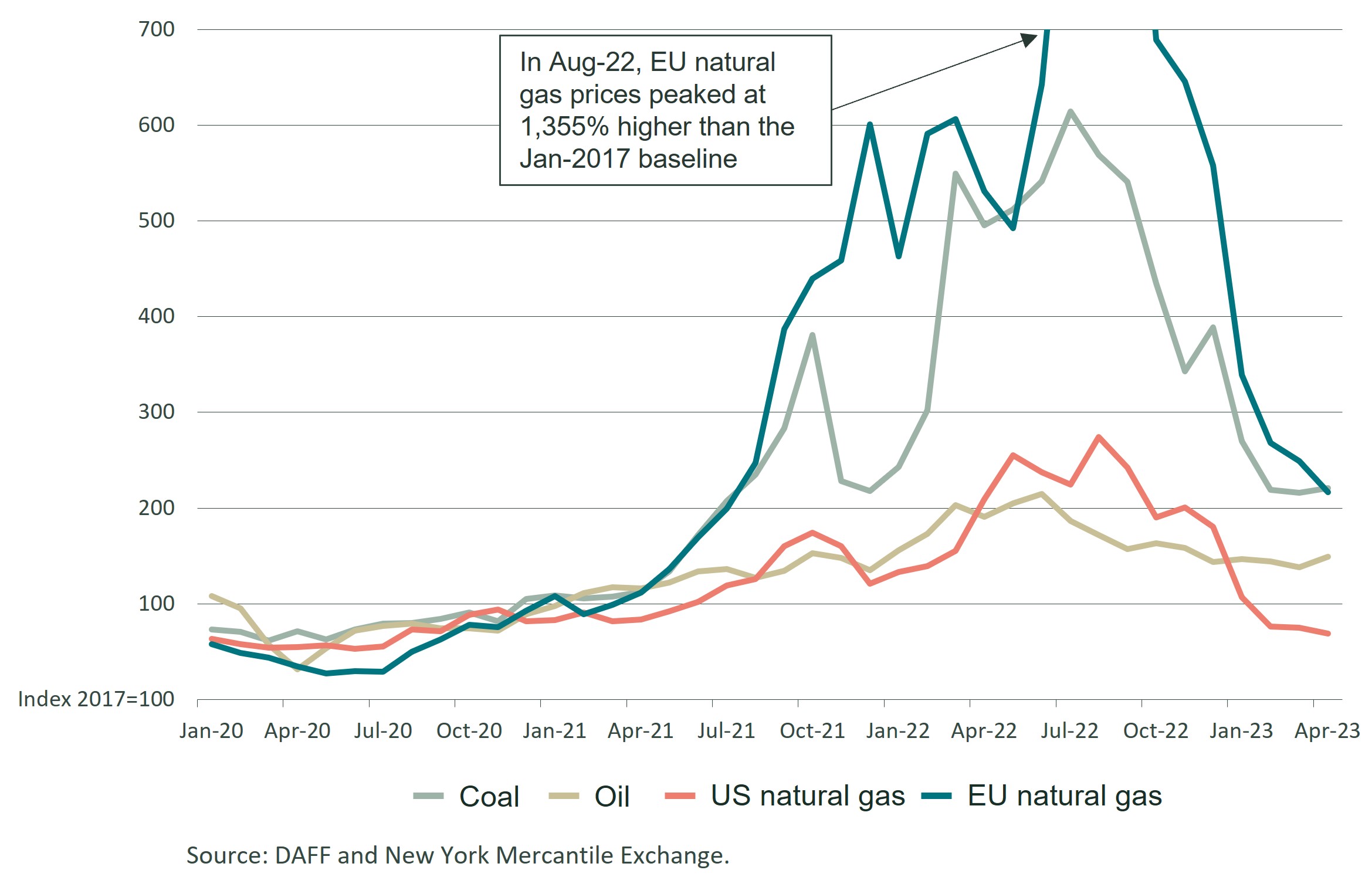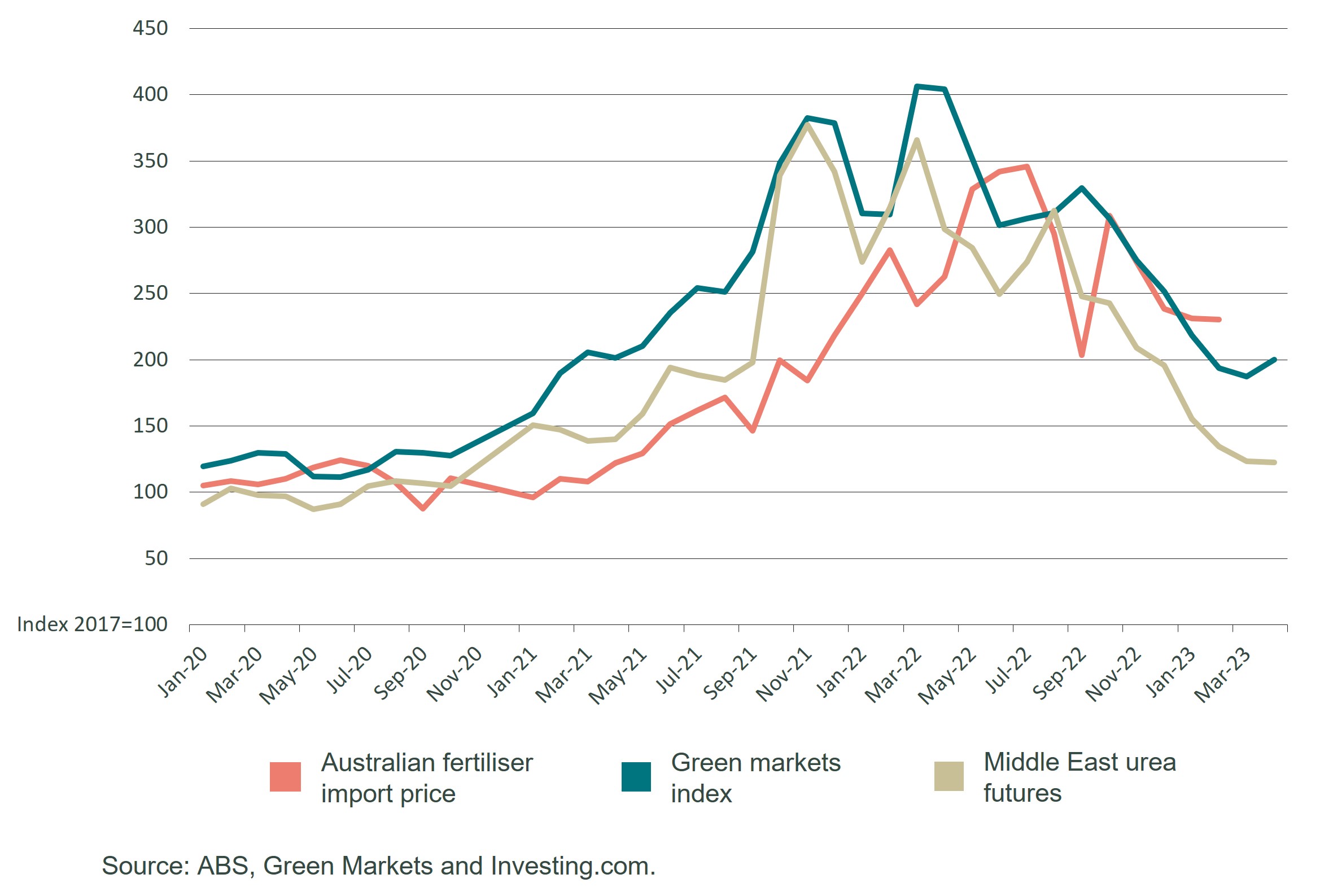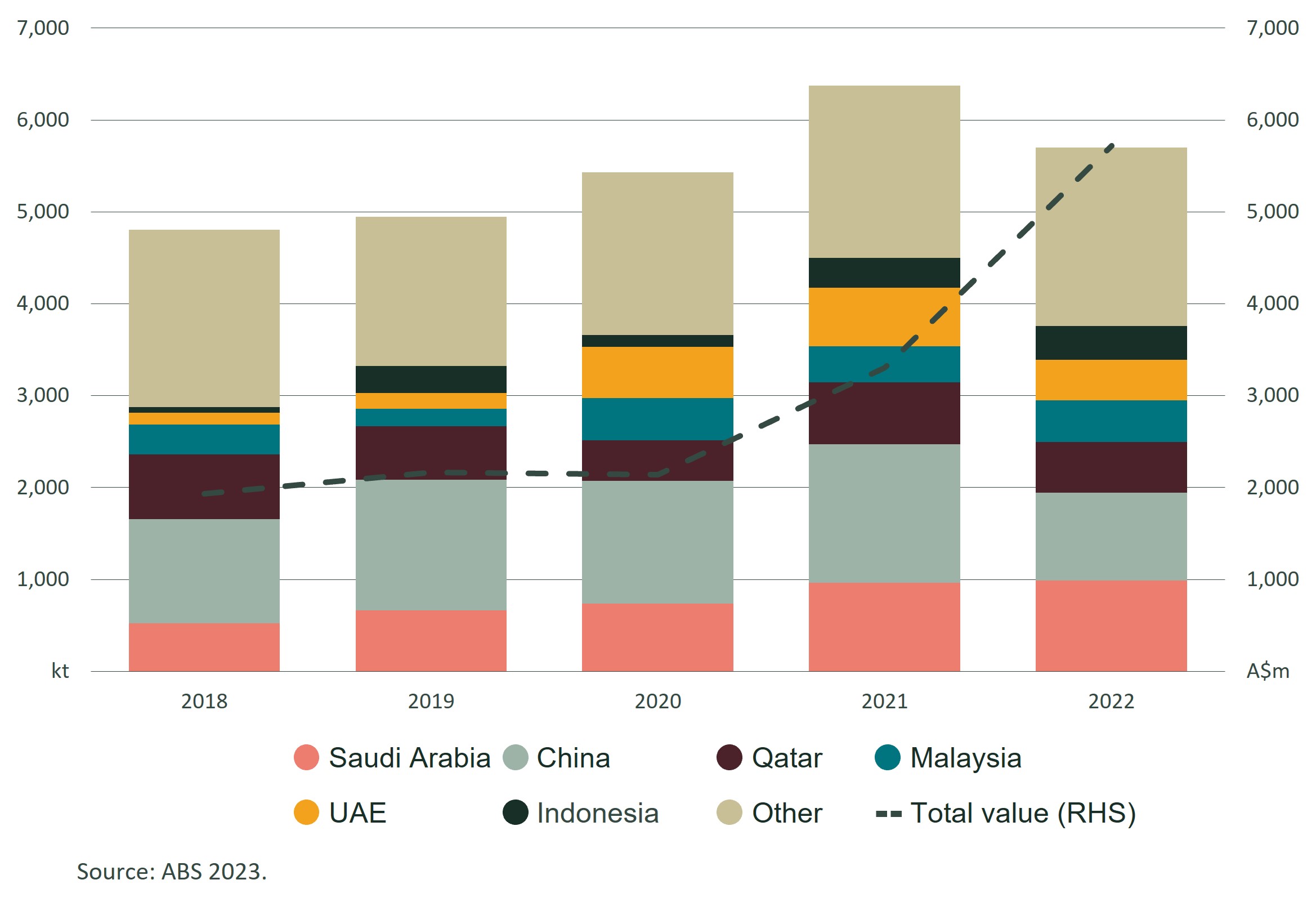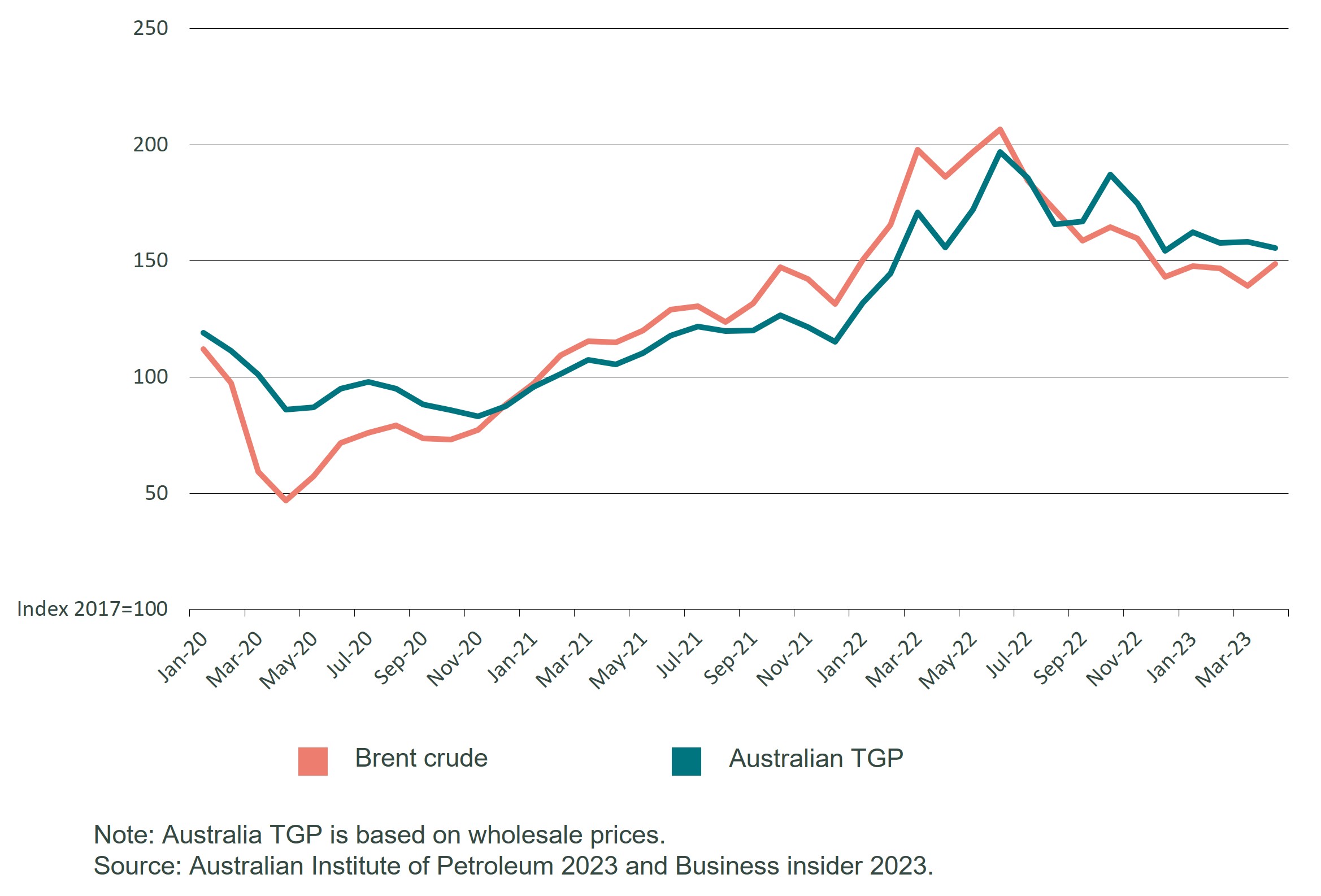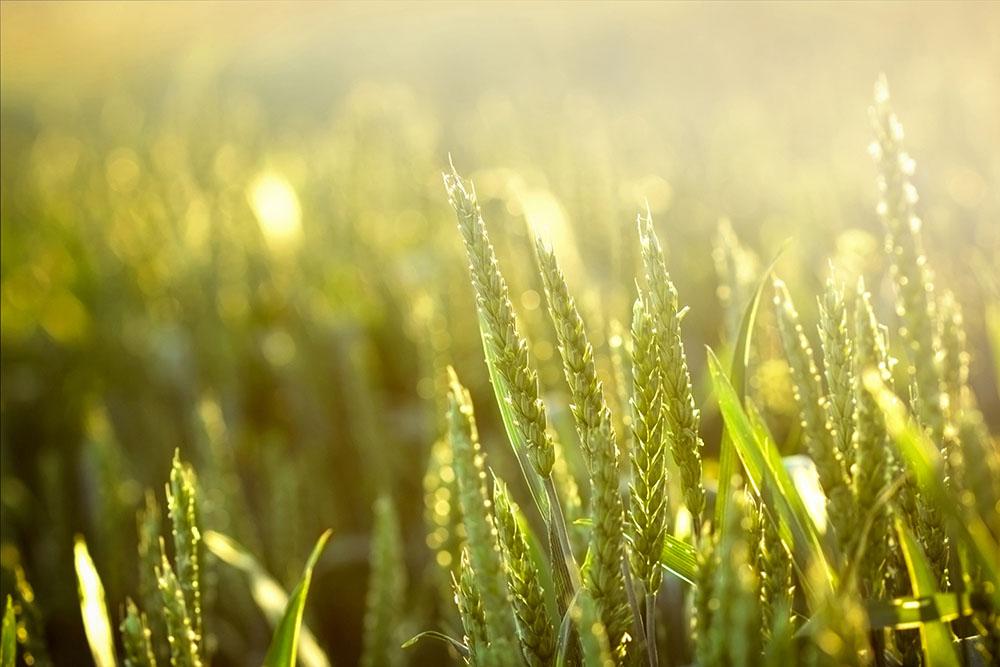High global energy prices and disruptions to global supply chains led to sharp rises in farm input costs, including fertiliser and diesel, in 2021 and 2022.
International energy prices have been falling since mid-2022. However, the cost of fertiliser and fuel remain higher than long-term averages for Australian farmers.
The lag between changes to international benchmark prices and domestic prices paid by Australian farmers is due to several factors, including:
- the time between energy production and its transformation into an input product
- the need to negotiate new contracts at the reduced pricing levels
- ongoing strength of the US dollar, which increases the cost of energy imports.
Futures markets are expecting the price of urea to stabilise at new, higher levels (CME Group 2023). Oil prices are hard to anticipate. However, slower economic growth and reduced industry activity should help ease some the pressure on diesel prices (IEA 2023).
Implications for Australian agricultural exporters
If market expectations are correct, Australian farmers are likely to continue experiencing elevated input costs for the foreseeable future. This will have implications for farm operations and profitability, particularly if global food prices fall or seasonal conditions worsen.
Rising global energy prices
Global energy prices increased steadily from April 2020, fell in late 2021 and increased again to mid-2022 (Figure 1). Initial rises were primarily due to unexpectedly high demand after the COVID-19 outbreak. Prices rose again in early 2022 following Russia’s invasion of Ukraine.
Global energy prices affect the price of key farm inputs, as several commodities are used as feedstock in the production process. For example, natural gas is used to make fertiliser, while oil is used to produce diesel.
Energy prices have fallen since mid-2022 (see Figure 1). European natural gas prices (Dutch TTF) have had the sharpest decline; however, decreases have been seen across all categories.
Energy prices have fallen due to a range of factors, including:
- a warm European winter
- the re-organisation of global supply chains in the months preceding Russia’s invasion of Ukraine
- a general slow-down in global economic activity.
Figure 1 - Spot energy price indexes, 1 January 2020 to 30 April 2023
The impact of higher input costs on Australian agriculture
Fertiliser and fuel purchases are a significant part of farm cash costs, particularly for cropping farms (Table 1).
Crop production is typically more energy-intensive because it requires more fertiliser. It is also more mechanised (machines that need diesel) than livestock farming.
Table 1 - Fertiliser and fuel costs as a percentage of total farm cash costs, 2018–19 to 2022–23
| Commodity | 2018–19 | 2019–20 | 2020–21 | 2021–22 | 2022–23f |
|---|---|---|---|---|---|
| Beef | 8.6% | 8.0% | 8.0% | 8.3% | 9.8% |
| Cropping | 24.6% | 26.4% | 24.0% | 27.7% | 34.0% |
| Dairy | 9.3% | 8.9% | 9.6% | 10.3% | na |
| Sheep | 11.3% | 11.5% | 11.5% | 12.2% | 16.2% |
f. ABARES forecast. Data is based on an average farm in the industry.
Source: ABARES 2023
In 2021–2022, fertiliser, fuel and grease accounted for a record 27.7% of total cash costs for cropping farms (Table 1). However, the proportion was steady for other farm types. This was primarily due to proportionate cost increases in other categories, rather than no change to fertiliser and fuel costs.
Elevated prices and high fertiliser application rates are expected to cause the share of farm cash costs accounted for by fertiliser and fuel to increase in 2022–2023. Fertiliser application rates are likely to increase as farmers seek to replenish soils following successive years of high-yielding crops (ABARES 2023).
Rising input prices were one of the factors that contributed to global food price rises in 2021 and 2022 (FAO 2023). Agricultural inputs costs are also evident in higher grocery prices in Australia (RBA 2023).
How falling global energy prices have impacted Australian agricultural producers
Fertiliser
Between February 2020 and July 2022, the average import price of Australian fertiliser increased by 153%. International fertiliser prices (Green markets index) and the spot price for urea in the Middle East also rose sharply over the same period (Figure 2).
Rising fertiliser prices were primarily caused by high natural gas prices (Figure 1) and decisions by Russia and China to reduce fertiliser exports.
International price decreases were reflected in falling fertiliser import prices in Australia between July 2022 and December 2022. Australian import prices continued to fall in January and February 2023. However, the falls were smaller than international benchmarks.
International indicators for March and April 2023 suggest that precipitous falls in fertiliser prices are slowing. Middle East urea futures contracts are valued at approximately US$336/tonne for the rest of 2023 (CME Group 2023). This compares with the January 2020 spot price of US$224/tonne.
If international prices settle at a new, higher level, we can expect Australian prices to also remain elevated.
Figure 2 - Fertiliser price indexes, 1 January 2020 to 30 April 2023
Disruptions to global supply chains and exports restrictions altered Australia’s usual pattern of fertiliser imports in 2022 (Figure 3). The volume of imports from major suppliers, including China (-36%), Qatar (-18%) and the United Arab Emirates (-31%) fell compared to 2021. Conversely, the volume of imports from other countries, including Bahrain, Morocco and the United States, rose. Australia also imported about 137 kilotonnes of fertiliser from Trinidad and Tobago in 2022 for the first time.
The long-term pricing outcomes for Australian fertiliser will partly depend on whether these new suppliers can provide product as efficiently as previous sources.
Figure 3 - Volume of Australian fertiliser imports by country and total value, 2018 to 2022
Diesel
Diesel is used in most on-farm agricultural machinery and to transport goods to market. Diesel prices rose in 2020 and 2022 due to:
- increased oil prices
- reduced global refinery capacity
- the reshuffling of trade following Russia’s invasion of Ukraine.
Australian wholesale diesel prices peaked at $2.28/litre in June 2022, up from $0.91/litre in April 2020 (+151%). Prices fell in the second half of 2022, before settling at around $1.80/litre in February to April 2023.
As of April 2023, Australian wholesale diesel prices have risen by 56%, relative to the 2017 average (Figure 4). Global oil prices are also higher (+49%). The gap between oil prices and diesel prices has been abnormally high in 2022–23. This is due to a range of factors, including:
- limited global capacity to refine oil into diesel
- disruptions to global trade
- the cheapness of diesel relative to natural gas.
The International Energy Agency expects reduced industrial activity to ease the pressure of diesel price. However, oil and diesel prices are extremely difficult to predict. Farmers have few options to limit the diesel use in the short-term. The outcome for diesel prices will have direct implications for a range of on-farm activities and will be reflected in the cost of agricultural products.
Figure 4 - Diesel price indexes, 1 January 2020 to 30 April 2023
Download
Snapshot - The impact of energy prices on agricultural inputs - May 2023 (PDF 310KB)
Snapshot - The impact of energy prices on agricultural inputs - May 2023 (DOCX 203KB)
If you have difficulty accessing these files, visit web accessibility for assistance.
Resources
The Australian Government’s network of Agriculture Counsellors provided information for this article. More information about the Agriculture Counsellor network, including contact details, is available on the Department of Agriculture, Fisheries and Forestry website.
This article was also published as an Austrade Insight.
Connect with us
Follow our @AusAgTrade Twitter account for all your #TradeTips and Market Intel.
Subscribe to our monthly Agriculture Market Intelligence Insights newsletter

